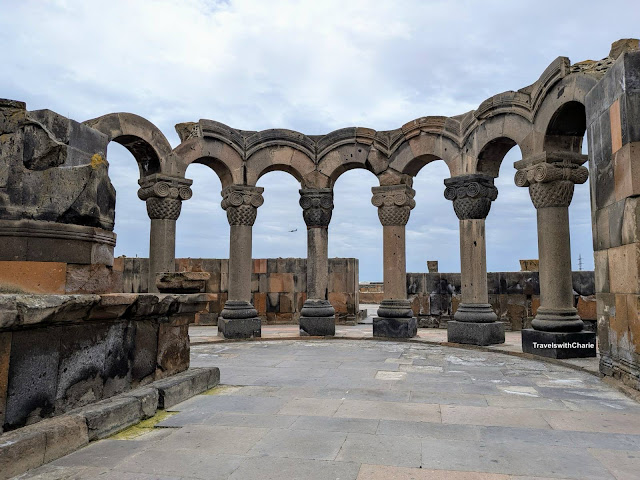Ruins of the Temple of Zvartnots
Zvartnots Temple was a three-storey circular structure built in the 7th century. Its beauty captivated the Byzantine Emperor, Constantine III, who brought the builder with him to Constantinople to build a similar structure. Unfortunately, the builder died along the way. Zvartnots Temple stood for around 300 years. By the 10th century, it was in ruins. It is not certain how it was destroyed. A strong earthquake may have caused its collapse or it may also have been due to continued Arab raids. The Zvartnots Archaelogical Site also includes the Catholicos Palace ruins which together with Etchmiadzin Cathedral became a UNESCO World Heritage Site in 2000.
Etchmiadzin (Echmiatsin) Cathedral
Armenia was the first country to adopt Christianity as the state religion in 301 AD. Etchmiadzin was built under the reign of King Tiridates III and Saint Gregory the Illuminator who introduced Christianity to Armenia. Etchmiadzin is the main church of the Armenian Apostolic Church. Its architectural plan consisting of a cruciform layout with a central dome has influenced not only ecclesiastical architecture in the region but also those in Eastern and Western Europe.
Altar - Etchmiadzin Church
The Church contains relics of the spear that pierced Jesus Christ (and which were originally kept at Geghard Monastery) as well as fragments believed to be that from Noah's ark.
Geghard Monastery
This monastery is named after the spear of Longinus that pierced the side of Jesus Christ during the Crucifixion. Geghardavank means monastery of the spear. That spear was presumably brought to Armenia by the apostle Jude Thaddeus. It was later transferred to the museum in Etchmiadzin. Geghard and the Upper Azat Valley were inscribed as a UNESCO World Heritage Site in 2000.

Octagonal Dome
Geghardavank was previously known as Ayrivank which means Monastery of the Cave. It was founded in the 4th century by St. Gregory the Illuminator. The current church was erected in 1215. Prior to that, the monastery complex was built inside a cave. The church is connected with the chapels and tombs dug from the rock.
 |
| Khachkar |
Khachkars are stone slabs or pillars used in the ancient world as gravestones, commemorative markers or as demarcation, often with carved ornamentation and in Armenia, with a cross representing the crucifixion of Christ. The Armenian Khachkar is a UNESCO Intangible Cultural Heritage object.
Garni Temple (UNESCO World Heritage Site Temporary List)
How to get there from Tbilisi, Georgia: I traveled to Armenia with G7 Euro Travel and Tours. Please check out my post about G7 here: https://www.travelswithcharie.com/p/travel-tips.html
Where to stay: Holiday Inn Express is a ten-minute walk to Republic Square and beside Mashtots Park. It's on Buzand 97/2. It offers free breakfast. Reservations link is ihg.com.
Currency in Armenia : Dram. $1.00 is equivalent to 383.23 dram (exchange rate on June 14, 2025).
Electrical outlet: Type C or F




